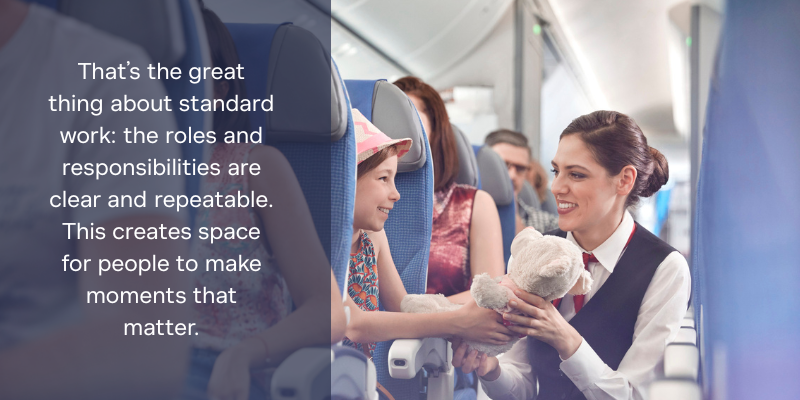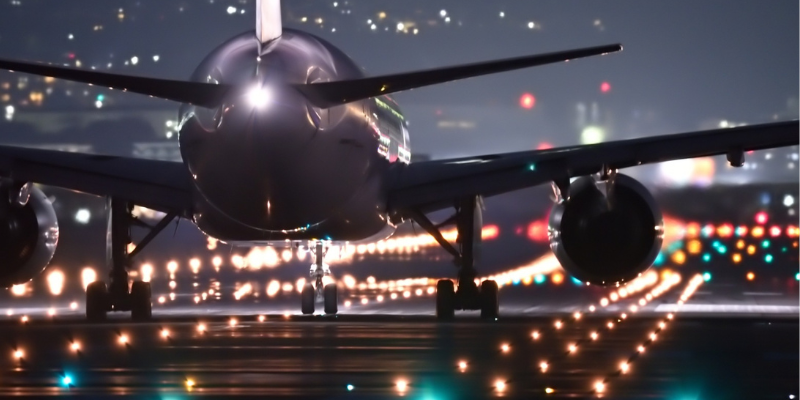When my flight from Washington State to Dallas made a bumpy impromptu landing in Oklahoma City due to weather, I knew I was in for a long day. If you’re a frequent traveler, chances are you’ve been stuck on a grounded flight mere yards from a gate. The internet is replete with horror stories of passengers sequestered on a stuffy plane with no water or food, limited information and rapidly declining phone batteries. It’s a terrible experience and often brings out the worst in people.
Flying High with Focus: What Airlines Teach Us About Prioritizing Work
Delays don’t bother me unless I’m late for a client meeting. I’ve always been fascinated by airplanes and airports. As a student of the human condition and a professional in organizational design, I find the processes involved in moving millions of people around the world incredible to contemplate.
Globally, more than 2,000 airlines operate 100,000+ flights per day. More than 2.9 million passengers are in the US skies each day. The industry is competitive, with each airline vying for repeat customers and, thankfully, it is highly regulated. Although you may experience sticker shock when purchasing a ticket, the airline industry operates on low margins, driven by high fixed costs, competitive pricing and fluctuating fuel prices.
While the customer experience may shape brand loyalty, it’s the compliance-driven work—safety checks, maintenance routines, air traffic coordination—that ensures passengers arrive safely. These tasks aren’t glamorous, but they are non-negotiable, and they exemplify the critical category of necessary work that must be executed with efficiency, precision, and consistency. To be successful, airlines must be clear and focused in how they prioritize and resource work.
This distinction isn’t unique to aviation; it’s essential in every industry. Understanding the difference between competitive and necessary work is foundational to designing organizations that are both strategic and scalable.
Competitive Work—Designed for Effectiveness
Work that differentiates a company from the competition needs to be identified and designed for effectiveness. This requires a sharp definition of the target customer and work that directly supports the strategy. This type of work is often resourced differently and is where best-in-class efforts are ideally utilized.
Necessary Work—Designed for Efficiency
Most of the work that organizations do is necessary and compliance-driven. In the airline industry, for example, much of this work includes safety checks, regulatory documentation, crew certifications, and maintenance protocols. These tasks may not set one airline apart from another, but they are essential—and tightly governed by external standards. This kind of compliant work, while not strategic in the competitive sense, must be executed with rigor and consistency. Necessary and compliance work should be organized for efficiency with a goal of being on par with the competition. It is also where standard and shared processes, automation, and a range of resourcing strategies are best utilized.
The Importance of Clear, Disciplined Work Categorization
Through many years of working with leaders, I’ve noticed a stumbling block in the way many think about competitive, necessary, and compliant work. When working through organization design trade-offs, often the inevitable fear of naming necessary and compliant work lands in the room. This fear can cause leaders to mislabel or misplace work, derailing productive outcomes of the design. Yet recognizing this work for what it is—not less important, but differently important—is a critical step toward organizational clarity and performance.
If organizations do not execute necessary and compliant work well, they may not be in business at all. For airlines, compliance with safety regulations is a basic requirement. If safety is not done well, there are significant consequences to the organization’s reputation and bottom line. Being on time is also table stakes—necessary work. While important and necessary to achieve, safety and being on time are not competitive differentiators. Truly competitive work is often less than 20 percent of work done by an organization. Competitive work is very specific to an organization and requires alignment with values, mission, vision, strategy, customer and defined capabilities. Some airlines differentiate themselves by level of service, others through cost. Being disciplined and clear with work categorization helps organizations know where to invest to achieve value and where to be on par.
American Airlines: A Model of Excellent Standard Work
Since we were unexpected guests at the Oklahoma City airport, we didn’t receive a gate assignment. You could sense the apprehension on our packed 737. Uncertain about how long we’d be stuck, worried about connections, luggage, and loved ones, and—speaking for myself—slightly nauseous from a bumpy landing on an already empty stomach.
Here’s what happened next. The captain and crew opened the airplane door to let in some fresh air and signaled that it was okay to get up if we needed to. The captain provided regular updates from air traffic control, even if it was just to say, “We do not know anything new.” We even received a technology briefing from the flight deck as to why the outlets on the plane would not charge our phones. In today’s world, connectivity is right up there with the necessities of food and water.
When it became clear we would be there for a while, a gate agent arrived from the terminal in a van to offer people the option of leaving the flight altogether. She came back every 30 minutes with the same option. Flight attendants, long out of water and ginger snaps, requested supplies from the terminal. On return trips from the terminal, the gate agent brought drinks and food. These were not standard airplane snacks. It looked like a break room was cleaned out of their big box variety bags of chips and mixed nuts.
Many of these activities were probably standard processes, perhaps revised from previous groundings gone wrong. Some, I’m confident, were creative problem-solving woven into standard work. That’s the great thing about standard work: the roles and responsibilities are clear and repeatable. This creates space for people to make moments that matter.

The captain and crew demonstrated thoughtful execution of both necessary and competitive work during our extended detour—balancing operational discipline with a human touch. We were on the ground in Oklahoma City for several hours, but honestly, it did not seem that long. The plane full of beleaguered passengers stayed calm and cooperative and displayed beautiful splashes of humanity. The man next to me shared his external phone battery charger. People in a row with a worn-out mom and a crying baby helped with her luggage. Some folks in the front section of the plane passed on snacks to ensure there were enough for passengers further back.
All the standard and required processes and procedures that American Airlines followed that day kept us safe and created an opportunity for the best possible experience. Bravo to the pilots and crew of Flight AA 484 for the leadership and example of going above and beyond to care for passengers. And bravo to American Airlines for setting the conditions for employees to be nimble and responsive to passengers while beautifully executing necessary (and important) work!





